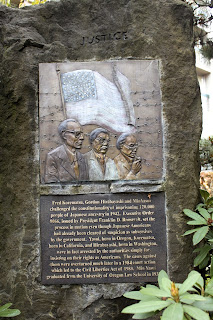Eugene Japanese American Art Memorial
By: Serena Pappas and Thumi Do
Located: Eugene, Oregon
Address: 1 Eugene Center
Eugene, OR 97401
Directions:
View Larger Map
Some pictures from our visit to the Memorial!
The Eugene Japanese American Art Memorial is a historical place in Eugene that was dedicated on February 19, 2007 to commemorate those who suffered through internment during wartime and to celebrate the contributions made by Japanese Americans to civil rights. We picked this site because many people don't know about it even though it is right in the middle of downtown Eugene located on Hult Center grounds. This memorial was built close to the actual site where Japanese Americans were forced to register to internment camps in 1942 after Japan bombed Pearl Harbor on December 7th, 1941. After that date, Japanese Americans and immigrants were targeted, attacked, and isolated by the rest of society. Other Asian ethnicities even put up signs outside their stores with sayings such as, “Proud to be American,” or, “Chinese,” to make sure everyone else knew they were not Japanese. At the site, there are three stones labeled Justice, Perseverance, and Honor.
The “Justice” stone honors Fred Korematsu, born in California, Gordon Hirabayashi, born in Washington, and Min Yasui, born in Oregon. These men challenged the constitutionality of Executive Order 9066, which allowed 120,000 people of Japanese ancestry to be imprisoned. Yasui, Korematsu, and Hirabayashi were arrested and the cases against them were not overturned until 1972 in a court action that led to the Civil Liberties Act of 1988.
The “Perseverance” stone honors the people who were confined inside the barbed wires that were these internment camps. It honors those who were guarded by armed sentries in watchtowers, those who lost everything they owned, and those who despite being imprisoned, supported America's war effort by working in the fields and going into the military service.
The “Honor” stone honors young Nisei (second-generation Japanese American) men who volunteered to serve their country in WWII in 1943.
We have been learning about racial inequality in our classes and how it has changed throughout time, and the internment of Japanese Americans is a good example of how society has turned on a certain race and isolated them. Executive Order 9066 issued by Franklin D. Roosevelt is also an example of a law that contributed to the social construction of whiteness by giving whites the power to intern Japanese Americans and immigrants.
Aerial Photo 1942
Aerial Photo 1946
References:
http://www.lesd.k12.or.us/tah/ejaam/index.html
Map Collection University of Oregon Library
Map Collection University of Oregon Library








